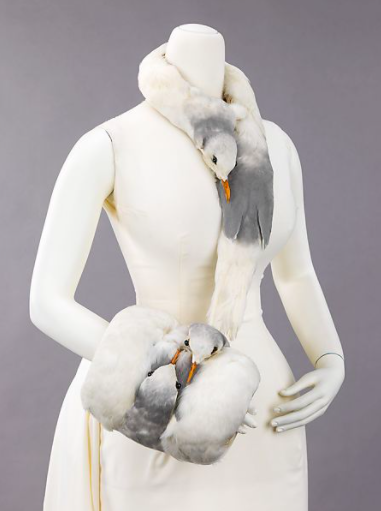OUR OSTRICH: TOWARDS A WILDER FUTURE
After spending almost two years searching for ostriches, four jumped out to their new wild home at our Ukuwela Reserve this August. Our re-wilded ostrich - LaPlume, Allison, Malcolm, and Ozzie - have settled in well and are truly fascinating birds. The history of ostrich in southern Africa is mixed with fashion, obsession, boom and bust. They are a bird that is both abundant and elusive - a contradiction in a tall, fast, feathered body. Learn more about the fascinating history of our newest arrivals in our latest blog.
LaPlume, one of our newly introduced male ostrich at Ukuwela.
The ostrich is likely the most popular and recognizable bird in Africa and is high on the list of iconic African species. Our newly introduced ostriches at Ukuwela are South African Ostrich (Struthio camelus australis), one of four sub-species of the common ostrich (Struthio camelus). They are also commonly known as the black-necked ostrich, Cape ostrich or southern ostrich. This August, our first four ostrich arrived - two females and two males - each individually sponsored by our donors as part of our wildlife reintroduction program at our fledgling Ukuwela Reserve in South Africa.
Ostriches serve an important role in the function of their ecosystem. They promote healthy growth and spread for plants by eating their seeds, fruits, and leaves. And while mainly vegetarian, they help maintain balanced populations by eating insects, reptiles, amphibians, and small rodents. They act as a food source for large predators and for animals that go after their eggs. They are also really fascinating and beautiful to observe, an iconic addition to our re-wilded landscape.
One of the new arrivals looks from the transport truck to his new home as the sun rises over Ukuwela.
In deciding to introduce ostrich at Ukuwela, we wanted to first determine if Zululand was historically their home. This turned out to be quite a difficult question to answer for the story of the ostrich in South Africa involves an epic boom and bust saga centered around the exotic feather market.
Lillian Russell - American actress - ostrich feather hat 1898. Source: Library of Congress.
In the mid-1800s, Europe was caught in the clutches of a feather craze. Fashionable women in Europe and North America wanted hats with feathers to show off their wealth and sophistication. The rarer and more beautiful the feather, the better. Sometimes they even attached the body of an entire bird to their hat, complete with glass eyes. It sounds creepy now, but this was the height of fashion during the Victorian and Edwardian eras. This demand for birds and their feathers cost the lives of millions of birds in an unregulated bird trade, including the ostrich in Africa.
“The Accessory Set” - made from the heads and feathers of gulls 1880-99. Brooklyn Museum Costume Collection at The Metropolitan Museum of Art, Gift of the Brooklyn Museum, 2009; Gift of Mrs. H. W. Garbe, 1965
During this fashion craze, the bigger and more ostentatious the feathers the better - that’s where ostrich come into this story. Ostrich were one of the most profitable birds at this time because they had the biggest and most fluffy of feathers and were easy to domesticate and farm. By the 1800s, South Africa had become the largest ostrich feather exporter in the world, driven by the feather craze in Europe and America. Ostrich became extremely valuable, commanding up to 1000 pounds for a pair of Ostrich during the height of the first feather boom. In fact, when the titanic sank in 1912, the most valuable cargo on board was reportedly a shipment of feathers, worth almost their weight in diamonds. By 1913 there were 776,268 ostriches owned by farmers within South Africa. Yet while the farming of ostrich boomed, in the wild they were pushed close to extinction, remaining only in the less accessible areas such as the Kalihari and the “Great Bushmanland deserts” of north eastern Namibia.
In North Africa, the famed “Barbary” ostrich (Struthio camelus camelus) was particularly under pressure with its “double floss” double-the-fluff plumes that were twice as profitable as regular Common Ostrich. Once the most numerous of all ostrich in Africa, they are now critically endangered.
This is where determining the native range of ostrich becomes tricky. Many farmers across South Africa took eggs from wild ostrich that lived in the more arid Western Cape region, and transported them all around the country to start their own farms, hoping to cash in on the feather craze. Therefore, it is hard to determine if and where wild ostriches previously ranged in KwaZulu-Natal. One hundred and fifty years of ostrich farming has blurred their feathered history and we were not able to find any conclusive evidence of their existence in our region prior to European arrival.
The feather trade and craze quickly went from boom to bust. There are several reasons for the demise of the international trade in feathers including: rising competition as ostrich could easily be farmed outside of Africa, legal protections for native birds, and most importantly, a tide of public opinion turning against the use of birds in fashion. This fashion trend, now referred to as Murderous Millinery, was perhaps the first to inspire animal activists to protest the use of wildlife in fashion. Their efforts lead to the Migratory Bird Treaty Act of 1918 in the United States (led by women, many of them New Yorkers) and the 1920 Plumage Bill by the Royal Society for the Protection of Birds in the U.K. Bird-watching became a hobby of middle-class suffragettes. Thanks to their efforts, the U.S. government also passed the Lacey Act to prevent the interstate trade in wild birds. The feather fashion fad was forced to dye out.
Other trends also worked against the feather trade: the rise of the automobile made large, fluffy hats far less practical, and World War I austerity promoted simpler, less ornate fashions. Thousands of people worldwide lost their jobs as the feather-and-giant-hat industry collapsed.
Today, the common ostrich has survived the feather craze and remains abundant and of ‘least concern’ from a conservation perspective. However, their population did suffer a major decline over the last 200 years due to the plume trade, hunting and the now constant threat of habitat loss. It is due to their vast range (9,800,000 square kilometres) that the IUCN and Bird Life International classify the common ostrich as as species of least concern. The Somali ostrich is listed as vulnerable, the North African Ostrich subspecies is critically endangered, and the Arabian Ostrich is already extinct (as of 1966). The vast majority of ostriches alive today are domestic hybrids, farmed for their meat, feathers and leather, which is why we had to wait so patiently -wild ostrich are simply very hard to come by in our region.
The decline of wild ostrich populations continues to fly under the radar, while farmed ostrich (for meat and leather) remain abundant. Within this context, we are happy to finally have our new flock settling in at their new home at Ukuwela Reserve. We continue to wait patiently for the opportunity to add to their numbers. For now, with the help of LaPlume, Allison, Malcolm, and Ozzie, we hope to spark action and awareness toward protecting wild ostrich populations, even if it begins in a potentially adopted part of their range.
A striking scene at Ukuwela - our four resident ostrich settling in (November 2020)
References
“The Accessory Set”. Brooklyn Museum Costume Collection at The Metropolitan Museum of Art, Gift of the Brooklyn Museum, 2009;https://www.metmuseum.org/art/collection/search/156834
BirdLife International. 2018. Struthio camelus. The IUCN Red List of Threatened Species 2018: e.T45020636A132189458. https://dx.doi.org/10.2305/IUCN.UK.2018-2.RLTS.T45020636A132189458.en. Downloaded on 22 November 2020.
Scully, William Charles. March 1918. The life of the African Ostrich. The Atlantic. https://www.theatlantic.com/magazine/archive/1918/03/life-african-ostrich/577285/
Souder, William. March 2013. How two women ended the deadly feather trade. The Smithsonian. https://www.smithsonianmag.com/science-nature/how-two-women-ended-the-deadly-feather-trade-23187277/
The Great Ostrich Heist. Atlas Obsucra. Accessed at: www.atlasobscura.com/articles/great-ostrich-heist
New York Historical Society exhibit, Feathers: Fashion and the Fight for Wildlife. April 06, 2018-July 15, 2018. Overview at: www.nyhistory.org/exhibitions/feathers-fashion-and-fight-wildlife





